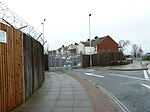Portsea Island is a flat and low-lying natural island 24.5 square kilometres (9.5 sq mi; 6,100 acres) in area, just off the southern coast of Hampshire in England. Portsea Island contains the majority of the city of Portsmouth.
Portsea Island has the third-largest population of all the islands in the British Isles after the mainlands of Great Britain and Ireland; it also has the highest population density of any British Isle, and Portsmouth has the highest population density of any city in the UK outside of London.To the east of Portsea Island lies Hayling Island, separated by Langstone Harbour. To the west is the peninsular mainland town of Gosport, separated by Portsmouth Harbour. To the south, it faces into the Spithead area of the wider Solent. A narrow tidal channel along the northern edge of Portsea Island, known as Portsea Creek, separates Portsea Island from the mainland.Three roads connect Portsea Island to the mainland road network; the M275 motorway, the A3 London Road (split on two separate bridges) and the A2030 Eastern Road. There are also two pedestrian and bicycle bridges over Portsea Creek. In Portsmouth Harbour, a road bridge connects Portsea Island to Whale Island, a restricted Royal Navy shore base establishment.
Portsea Island has four railway stations (Portsmouth Harbour, Portsmouth & Southsea, Fratton and Hilsea) connected by an island branch line to the mainland railway network via a short railway bridge over Portsea Creek. In addition there are ferry services to Gosport (on the mainland), Hayling Island and the Isle of Wight. There are also ferries to the Channel Islands, northern France and northern Spain.
Portsea Island gives its name to a neighbourhood of Portsmouth historically known as The Common, now formally known as Portsea and also the Portsea Parish of the island.









